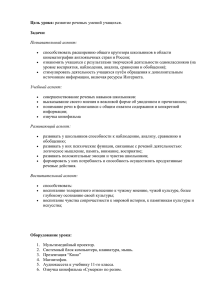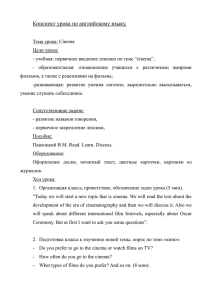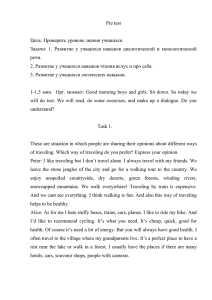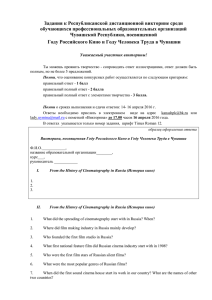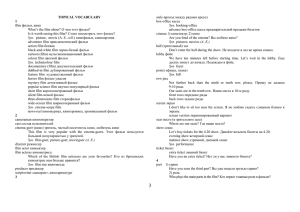High-performance-superconducting-join 2021 Physica-C--Superconductivity-and-
реклама
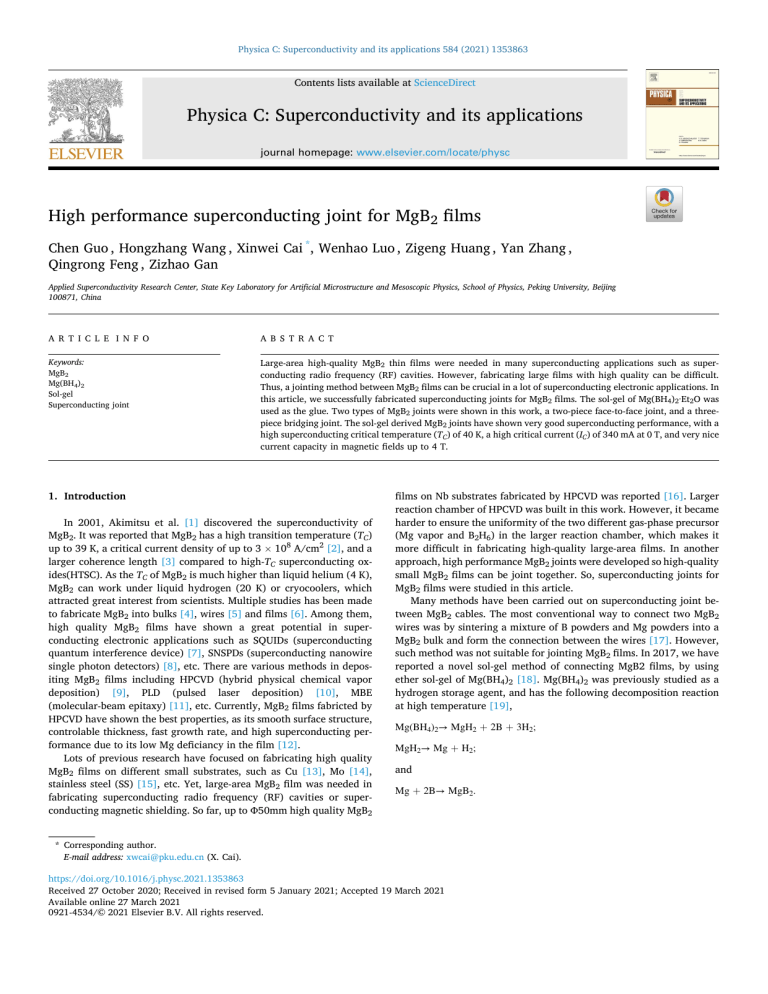
Physica C: Superconductivity and its applications 584 (2021) 1353863 Contents lists available at ScienceDirect Physica C: Superconductivity and its applications journal homepage: www.elsevier.com/locate/physc High performance superconducting joint for MgB2 films Chen Guo , Hongzhang Wang , Xinwei Cai *, Wenhao Luo , Zigeng Huang , Yan Zhang , Qingrong Feng , Zizhao Gan Applied Superconductivity Research Center, State Key Laboratory for Artificial Microstructure and Mesoscopic Physics, School of Physics, Peking University, Beijing 100871, China A R T I C L E I N F O A B S T R A C T Keywords: MgB2 Mg(BH4)2 Sol-gel Superconducting joint Large-area high-quality MgB2 thin films were needed in many superconducting applications such as super­ conducting radio frequency (RF) cavities. However, fabricating large films with high quality can be difficult. Thus, a jointing method between MgB2 films can be crucial in a lot of superconducting electronic applications. In this article, we successfully fabricated superconducting joints for MgB2 films. The sol-gel of Mg(BH4)2·Et2O was used as the glue. Two types of MgB2 joints were shown in this work, a two-piece face-to-face joint, and a threepiece bridging joint. The sol-gel derived MgB2 joints have shown very good superconducting performance, with a high superconducting critical temperature (TC) of 40 K, a high critical current (IC) of 340 mA at 0 T, and very nice current capacity in magnetic fields up to 4 T. 1. Introduction In 2001, Akimitsu et al. [1] discovered the superconductivity of MgB2. It was reported that MgB2 has a high transition temperature (TC) up to 39 K, a critical current density of up to 3 × 108 A/cm2 [2], and a larger coherence length [3] compared to high-TC superconducting ox­ ides(HTSC). As the TC of MgB2 is much higher than liquid helium (4 K), MgB2 can work under liquid hydrogen (20 K) or cryocoolers, which attracted great interest from scientists. Multiple studies has been made to fabricate MgB2 into bulks [4], wires [5] and films [6]. Among them, high quality MgB2 films have shown a great potential in super­ conducting electronic applications such as SQUIDs (superconducting quantum interference device) [7], SNSPDs (superconducting nanowire single photon detectors) [8], etc. There are various methods in depos­ iting MgB2 films including HPCVD (hybrid physical chemical vapor deposition) [9], PLD (pulsed laser deposition) [10], MBE (molecular-beam epitaxy) [11], etc. Currently, MgB2 films fabricted by HPCVD have shown the best properties, as its smooth surface structure, controlable thickness, fast growth rate, and high superconducting per­ formance due to its low Mg deficiancy in the film [12]. Lots of previous research have focused on fabricating high quality MgB2 films on different small substrates, such as Cu [13], Mo [14], stainless steel (SS) [15], etc. Yet, large-area MgB2 film was needed in fabricating superconducting radio frequency (RF) cavities or super­ conducting magnetic shielding. So far, up to Φ50mm high quality MgB2 films on Nb substrates fabricated by HPCVD was reported [16]. Larger reaction chamber of HPCVD was built in this work. However, it became harder to ensure the uniformity of the two different gas-phase precursor (Mg vapor and B2H6) in the larger reaction chamber, which makes it more difficult in fabricating high-quality large-area films. In another approach, high performance MgB2 joints were developed so high-quality small MgB2 films can be joint together. So, superconducting joints for MgB2 films were studied in this article. Many methods have been carried out on superconducting joint be­ tween MgB2 cables. The most conventional way to connect two MgB2 wires was by sintering a mixture of B powders and Mg powders into a MgB2 bulk and form the connection between the wires [17]. However, such method was not suitable for jointing MgB2 films. In 2017, we have reported a novel sol-gel method of connecting MgB2 films, by using ether sol-gel of Mg(BH4)2 [18]. Mg(BH4)2 was previously studied as a hydrogen storage agent, and has the following decomposition reaction at high temperature [19], Mg(BH4)2→ MgH2 + 2B + 3H2; MgH2→ Mg + H2; and Mg + 2B→ MgB2. * Corresponding author. E-mail address: [email protected] (X. Cai). https://doi.org/10.1016/j.physc.2021.1353863 Received 27 October 2020; Received in revised form 5 January 2021; Accepted 19 March 2021 Available online 27 March 2021 0921-4534/© 2021 Elsevier B.V. All rights reserved. C. Guo et al. Physica C: Superconductivity and its applications 584 (2021) 1353863 Mg(BH4)2 first decomposed into MgH2 at ~300◦ C, and released all its hydrogen round 500◦ C, then eventually formed MgB2. Using the sol-gel as the bonding glue, MgB2 films can be pasted face-to-face. After the heat treatment, Mg(BH4)2 sol-gel formed a stable MgB2 joint, firmly bond the MgB2 films together [20]. 2. Experiment 2.1. Preparation of MgB2 films The MgB2 films were prepared on a 5 × 10 mm 6H-SiC substrate by HPCVD. The details of the HPCVD process have been introduced in the previous paper [21]. 5% B2H6 flowed into the heating chamber, and decomposed into B at high temperature, which provided the B source of HPCVD. The Mg ingots were put into the heating chamber and heated to 690◦ C, which sublimated to form Mg vapor as the Mg source. The B decomposed from B2H6 finally reacted with Mg vapor and formed MgB2 films in 4 kpa on the surface of the SiC substrate. Fig. 2. The heating process. 2.2. Preparation the sol of Mg(BH4)2• Et2O joint the films. Then the sample slowly cooled to room temperature, and was took out of the furnace. After removing the clamp, the films were firmly connected together. The preparation of Mg(BH4)2 sol-gel was carried out as the following reaction: 2.5. Testing and Characterization 2NaBH4 + MgCl2→Mg(BH4)2 + 2NaCl↓. Since Mg(BH4)2 is soluble in ether while NaCl is not, the NaCl and some unreacted NaBH4 and MgCl2 in the product can be removed by filtration. In this way, a Mg(BH4)2• Et2O solution can be obtained. In order to meet the requirement of the joint, the filtered Mg(BH4)2 sol must be continuously concentrated, and finally a thick Mg(BH4)2• Et2O gel can be prepared. The surface and joint section sample were inspected by a QUAN­ TA200FEG scanning electron microscope (SEM). The R-T curves of the joint sample were measured by the 4-probe method, while the current and voltage leads soldered on each surface of the jointing MgB2 films (Fig. 1b). The I-V curves of joint sample were obtained by PPMS (Quantum Design Physical Properties Measurement System) with similar 4-probe method. The thickness of the MgB2 films were test by a profilometer. 2.3. Jointing MgB2 films The Mg(BH4)2• Et2O sol-gel was coated evenly on the surface of the MgB2 films, and the films were then glued face to face together. Since the sol-gel will release a large amount of gas during the heat treatment, which affected the stability of the joint, a clamp was used to fix the two films together. Two types of joints were made in this article. One is a face-to-face joint using two MgB2 films, and the other is a bridging joint using 3 films (Fig. 1a). 3. Result and Discussion 3.1. Electrical properties 3.1.1. Resistance of the joint sample The resistance dependence on temperature of the samples were measured by a standard four-probe method. The current used in the measurement was initially set to 60 μA. Both face-to-face joint and bridging joint showed a great performance of the joint at low current. The R-T curve of the face-to-face joint in 60 μA was shown in Fig. 3a. The onset transition temperature TC(onset) was 40.7 K, and the zeroresistance temperature TC(0) was 40.5 K, with a transition width ∆T about only 0.2 K. The bridging joint sample showed the same incredible high TC up over 40 K like the face-to-face joint sample shown in Fig. 3a. Such high TC and fairly short ∆T can be comparable with highperformance MgB2 superconducting films fabricated by HPCVD in other works [22]. This means that the joint sample perfectly maintained the good performance of MgB2 films, ensuring that the sample can work 2.4. Heat treatment The sample was placed in a furnace, and Ar was used as the working atmosphere to prevent the Mg in the sol from being oxidized. The entire heating curve is shown in Fig. 2. First, the furnace temperature slowly increased to 200◦ C within 90 minutes, and maintained at 200◦ C for 60 minutes, in order to completely volatilize the ether in the sol. Then, the furnace temperature slowly increased from 200◦ C to 600◦ C in 120 mi­ nutes, and kept at 600◦ C for 30 minutes. In this process, Mg(BH4)2 gradually decomposed into Mg and B, and finally formed MgB2 which Fig. 1. (a) the face-to-face joint sample and the bridging joint sample. (b) the current and voltage leads on the joint sample. 2 C. Guo et al. Physica C: Superconductivity and its applications 584 (2021) 1353863 superconducting joint has been proven capable for jointing super­ conducting electronic devices, which will be our focus in the future studies. In order to further inspect the superconducting properties of the joint to confirm whether our joints properly jointing the two films, the test current was then increased to 100 mA. The R-T curve of the face-to-face joint in 100 mA was shown in Fig. 3b. By taking the logarithm of the curve, a clear double transition can be observed in the figure. The first transition began at 33 K and the second transition began at 38 K. The resistance of the sample below 33 K was lower than 1.0 × 10− 7 Ω, which reached the limit of our measuring system, and it raised to 1.61 × 10− 5 Ω in 33 K – 38 K on average, then the sample lost its superconductivity over 38 K. Apperently, the double transition comes from the transition of the joint and the original HPCVD films. The first transition at 33 K was corresponding to the superconducting transition of the MgB2 at the junction formed by the Mg(BH4)2• Et2O sol-gel. The second transition at 38 K was corresponding to the the superconducting transition of the MgB2 films by HPCVD, which was comparable to our testing result on a reference bare HPCVD MgB2 film. The degradation on TC was due to the high test current (almost 1/3 of the IC of the sample), and the difference degradation on TC tells the joint and the films apart. The R-T curve of the bridging joint sample in 100 mA was shown in Fig. 3c. Compare with the face-to-face joint sample, the bridging joint sample shows the similar trend on the R-T curve. A double transition can also be observed in the figure. The MgB2 at the junction began its superconducting transition at 26 K, and the resistance of the juction raised from 1.0 × 10− 7 Ω to 2.4 × 10− 3 Ω. The second transition started at the same 38 K, then the joint sample turned into a normal state. Due to the increase of the films to be joint, the first transistion, majorly deter­ mined by the Mg(BH4)2 derived MgB2, has shown a lower TC and higher normal state resistance. On the other hand, the HPCVD MgB2 films has shown almost identical TC values in different jointing practices, which indicated that the sol-gel process does not deteriorate the original film. Such result can be proved by the following SEM image in Fig. 5f. As can be seen from the previous R-T curves, with the increasement of the test current, the TC of the MgB2 films decreased from 40.7 K to 38 K, while the TC of the joint decreased more. For type-II superconductors, the variation of the upper critical field HC2 with temperature can be written as { ( )2 } T HC2 (T) = HC2 (0) 1 − . TC The test current i generated a magnetic field Hi on the surface of the sample. When Hi < HC2, MgB2 was at the superconducting state. When Hi reached HC2, MgB2 turned into nomal state. As Hi = HC2 (Ti), Ti is equal to the transition temperature of MgB2 at test current i. The test current increased from 60 μA to 100 mA, causing the decrease on the TC of MgB2. The transition temperature of MgB2 films at 100mA was 38 K. The transition temperature of face-to-face MgB2 joints at 100 mA was 33 K. The transition temperature of bridging MgB2 joints at 100 mA was 26 K. By applying Ginzburg-Landaw equations, HC2 have the following relation with critical current density JC, JC ∝HλC2 . Thus the JC in the Mg (BH4)2 derived MgB2 joints were lower than HPCVD MgB2 films. We suspect that the difference in the structure of MgB2 leads to different JC. The MgB2 films had a better density and connectivity than the MgB2 joints, which can be proved by the following SEM images. In addition, with the increase of joint parts, the JC of the bridging joints were much lower than the face-to-face joints, which means that the deterioration of sample performance at 100 mA was due to the joint part formed by the Mg(BH4)2 sol-gel. Although the JC of the joint part is lower than the JC of the film, we can still obtain a higher critical current IC by increasing the area of the connection to meet the requirements in the application. Besides, the transition temperature of the joints at 100 mA was much higher than the working temperature of MgB2 cavities [23], which means that the joint sample was still good enough under a high working Fig. 3. (a) The R-T curve of the face-to-face joint sample. Test current is 60 μA. TC is about 40.7 K. (b) The R-T curve of the face-to-face joint sample. Test current is 100 mA. The first TC is about 33 K. The second TC is about 38 K. (c) The R-T curve of the bridging joint sample. Test current is 100 mA. The first TC is about 27 K. The second TC is about 38 K. under the same conditions as the MgB2 films. In addition, this also proves that the joint process hardly affected the electrical properties of the films at low current, which meeting our requirements for preparing large-area films. In most superconducting electronic applications, the current in the films are around the level of 10-100 μA. As a result, our 3 C. Guo et al. Physica C: Superconductivity and its applications 584 (2021) 1353863 current. 3.1.2. I-V measurement of the joint sample The voltage-current(I-V) measurement was performed at 5K by PPMS. The I-V curve of the joint sample under varied magnetic fields was shown in Fig. 4a. The magnetic field gradually increased from 0 T. At 0 T, the critical current (IC) of the sample was as high as 340 mA. As the magnetic field increased, the IC of the sample decreased. The joint sample lost its superconductivity as the magnetic field higher than 4 T. The IC under various magnetic fields was shown in Fig. 4b. By magni­ fying the I-V curves, as shown in Fig. 4c, a different transition trend can be found in the joint samples compared with MgB2 films by HPCVD [24]. There was a second transition of the slope on the I-V curves before the current reached IC. Obviously, this special electrical property was caused by MgB2 formed by Mg(BH4)2•Et2O sol-gel at the juction. In order to observe this transition more clearly, a differential analysis has been performed on the I-V curve of the joint sample at 0 T, as shown in Fig. 4d. The slope of the curve can be considered as the residual resistance of the sample. The average resistance was about 1.58 × 10− 7 Ω as the current below 220 mA. This is mainly caused by the systematic error in the measurement. Then the resistance slowly raised to 1.97 × 10− 5 Ω as the current increased to 220 mA. Similar phenomenon usually appeared in the I-V measurement of multifilament superconductors [25]. The explanation for this was a result of current sharing among multifilament. The current unbalance among the different super­ conducting channels led to interchannel resistance [26], which caused an additional residual resistance before the current reached IC. So, we speculate that the MgB2 at the juction could behaved like multifilament superconductors, which indicated that the joint MgB2 had a multi-channel structure. This conjecture was confirmed by the following SEM images. 3.2. Electron microscopy SEM was introduced to observe the microstructure of the joint. The cross section of the joint sample has been shown in Fig. 5a. The upper and lower substrates can be clearly seen in the figure. Between the two substrates, an obvious bright line was observed, which represent the MgB2 formed by Mg(BH4)2•Et2O sol-gel connecting two MgB2 films, as MgB2 has much better conductivity than SiC in room temperature. Some random excessive MgB2 were attached on the surface of the upper and lower substrates, as shown in Fig. 5a. Due to the pressure of clamp on the sample, some of the sol-gel was squeezed out from the jointing area during the jointing process, and eventually formed MgB2 adhered on the side of the substrate after heat treatment. In order to see the juction more clearly, a higher magnitude image was shown in Fig. 5b. The upper and lower flat surface corresponded to the SiC substrates. The joint layer can be seen in the middle of the image, with the thickness about 2 μm. A bright line can be found on the surface of the upper substrate, which representing the HPCVD MgB2 film, with the thickness about 60 nm, comparable to our result measured by profilometer. It can be seen from the image that MgB2 at the juction connected the upper and lower MgB2 films, which means that the MgB2 joint we fabricated had successfully jointing the two films. Also, the edge of the joint sample was observed, as shown in Fig. 5c. The upper and lower substrates can also be easily found in the figure. A thick layer of MgB2 covered the edge of the juction, and parts of it extended to the lower SiC substrate. This part of MgB2 came from the Mg (BH4)2•Et2O sol-gel which were squeezed from the joint section and eventually formed MgB2. The higher magnitude image of this MgB2 layer was shown in Fig. 5d. The right part of the figure was the side of the upper substrate, and the lower part corresponded to the lower substrate. It can be seen from the figure that the layer of MgB2 covering the surface of the substrate was very dense. Moreover, no cracks or pores were seen at the edge of juction on this MgB2 layer, which proved that the joint was strong and stable. Fig. 4. (a) The I-V curve of the joint sample under varied external magnetic fields. (b) Critical current under varied magnetic fields (from 0T to 3T). (c) Partially magnified the I-V curve of the joint sample.(d) Differential curve of the I-V curve at 0T 4 C. Guo et al. Physica C: Superconductivity and its applications 584 (2021) 1353863 Fig. 5. (a) Cross section of the joint sample. (b) Higher magnitude image of (a). (c) Edge of the joint sample. (d) Higher magnitude image of (c). (e) Joint area after breaking apart the sample. (f) Lower layer of (e). (g) Higher layer of (e). 5 C. Guo et al. Physica C: Superconductivity and its applications 584 (2021) 1353863 The surface morphologies of the juction after breaking the joint sample apart was shown in Fig. 5e,. The figure shows two parts of the sample. The lower layer was flat, corresponding to the MgB2 film before joint, while the higher layer corresponded to the joint layer. Fig. 5f shows a higher magnitude image of the lower part. This image is similar with the surface morphologies of clean MgB2 films grown on 6H-SiC in previous works [22],which demonstrates that the microstructure of MgB2 films will not be affected by the sol-gel process. Fig. 5g shows a higher magnitude image of the joint layer. Bubbles and gaps can be seen inside the juction. The reason for this structure is that the Mg(BH4)2• Et2O sol-gel generated a large amount of gas (ether and H2) during the heating process, and like most sol-gel process, the sol-gel shrinked significantly in volume after the heat treatment. The decrease of the sol-gel in volume caused gaps, while the generation of the gases caused bubbles. These gaps and bubbles created a multi-channel connection between the two films, which proved our previous conjecture about the interchannel resistance [27]. Besides, the release of ether result in pressure in the junction during the early stage of the heat treatment, which squeezed some of the sol-gel out of the jointing area. The extruded sol-gel eventually formed MgB2 and adhered to the underlying substrate, as shown in Fig. 5a and c. The SEM images above indicate that the superconducting joint of MgB2 films was successfully fabricated by the Mg(BH4)2• Et2O sol-gel. The MgB2 joint firmly bonded two films together, with no crack can be observed from the edge of juction. The thickness of the juction was about 2μm. From the surface morphology of the joint layer, it can be seen that MgB2 at the joint has a porous structure. Compared with the MgB2 films, the density of MgB2 at the junction was worse, leading to the decrease of JC. This phenomenon was even more obvious in the bridging joint sample. Besides, this multi-channel like structure leads to a inter­ channel resistance in I-V measurement. Reference [1] J. Nagamatsu, N. Nakagawa, T. Muranaka, Y. Zenitani, J. Akimitsu, Superconductivity at 39 K in magnesium diboride, Nature 410 (6824) (2001) 63–64, 2001/03/01. [2] C.G. Zhuang, S. Meng, C.Y. Zhang, Q.R. Feng, Z.Z. Gan, H. Yang, Y. Jia, H.H. Wen, X.X. Xi, Ultrahigh current-carrying capability in clean MgB2 films, Journal of Applied Physics 104 (1) (2008), 013924, 2008/07/01. [3] C. Buzea, T. Yamashita, Review of the superconducting properties of MgB2, Superconductor Science and Technology 14 (11) (2001) R115–R146, 2001/11/01. [4] J.M. Rowell, The widely variable resistivity of MgB2samples, Superconductor Science and Technology 16 (6) (2003) R17–R27, 2003/04/30. [5] S. Jin, H. Mavoori, C. Bower, R.B. van Dover, High critical currents in iron-clad superconducting MgB2 wires, Nature 411 (6837) (2001) 563–565, 2001/05/01. [6] C.B. Eom, M.K. Lee, J.H. Choi, L.J. Belenky, X. Song, L.D. Cooley, M.T. Naus, S. Patnaik, J. Jiang, M. Rikel, A. Polyanskii, A. Gurevich, X.Y. Cai, S.D. Bu, S. E. Babcock, E.E. Hellstrom, D.C. Larbalestier, N. Rogado, K.A. Regan, M. A. Hayward, T. He, J.S. Slusky, K. Inumaru, M.K. Haas, R.J. Cava, High critical current density and enhanced irreversibility field in superconducting MgB2 thin films, Nature 411 (6837) (2001) 558–560, 2001/05/01. [7] A. Brinkman, D. Veldhuis, D. Mijatovic, G. Rijnders, D.H.A. Blank, H. Hilgenkamp, H. Rogalla, Superconducting quantum interference device based on MgB2 nanobridges, Applied Physics Letters 79 (15) (2001) 2420–2422, 2001/10/08. [8] H. Shibata, T. Akazaki, Y. Tokura, Fabrication of MgB2Nanowire Single-Photon Detector with Meander Structure, Applied Physics Express 6 (2) (2013), 023101, 2013/02/01. [9] X.H. Zeng, A.V. Pogrebnyakov, M.H. Zhu, J.E. Jones, X.X. Xi, S.Y. Xu, E. Wertz, Q. Li, J.M. Redwing, J. Lettieri, V. Vaithyanathan, D.G. Schlom, Z.-K. Liu, O. Trithaveesak, J. Schubert, Superconducting MgB2 thin films on silicon carbide substrates by hybrid physical–chemical vapor deposition, Applied Physics Letters 82 (13) (2003) 2097–2099, 2003/03/31. [10] K. Jihoon, R.K. Singh, N. Newman, J.M. Rowell, Thermochemistry of MgB/sub 2/ thin film synthesis, IEEE Transactions on Applied Superconductivity 13 (2) (2003) 3238–3241. [11] K. Ueda, H. Yamamoto, M. Naito, Synthesis and photoemission study of as-grown superconducting MgB2 thin films, Physica C: Superconductivity 378-381 (2002) 225–228, 2002/10/01/. [12] F. Qing-rong, C. Chinping, L. Ying, J. Zhang, G. Jing-pu, W. Xiao-nan, Z. Meng, X. Jun, and W. Yong-Zhong, MgB2 thick film grown on stainless steel substrate with ductility. [13] F. Li, T. Guo, K. Zhang, L.-p. Chen, C. Chen, Q.-r. Feng, Thick polycrystalline MgB2film on Cu substrate by hybrid physical–chemical vapour deposition, Superconductor Science and Technology 19 (11) (2006) 1196–1199, 2006/10/18. [14] C. Zhuang, D. Yao, F. Li, K. Zhang, Q. Feng, Z. Gan, Study of micron-thick MgB2films on niobium substrates, Superconductor Science and Technology 20 (3) (2007) 287–291, 2007/02/14. [15] F. Li, T. Guo, K. Zhang, C. Chen, Q.-r. Feng, Progress in depositing MgB2 films on stainless steel substrate, Physica C: Superconductivity 452 (1) (2007) 6–10, 2007/ 02/01/. [16] Z. Ni, X. Guo, P.B. Welander, C. Yang, M. Franzi, S. Tantawi, Q. Feng, K. Liu, Fabrication and radio frequency test of large-area MgB2 films on niobium substrates, Superconductor Science and Technology 30 (4) (2017), 045009, 2017/ 02/28. [17] X.H. Li, L.Y. Ye, M.J. Jin, X.J. Du, Z.S. Gao, Z.C. Zhang, L.Q. Kong, X.L. Yang, L. Y. Xiao, Y.W. Ma, High critical current joint of MgB2tapes using Mg and B powder mixture as flux, Superconductor Science and Technology 21 (2) (2008), 025017, 2008/01/23. [18] L.P. Chen, C. Zhang, Y.B. Wang, Y. Wang, Q.R. Feng, Z.Z. Gan, J.Z. Yang, X.G. Li, A sol–gel method for growing superconducting MgB2films, Superconductor Science and Technology 24 (1) (2010), 015002, 2010/12/03. [19] H.W. Li, K. Kikuchi, Y. Nakamori, N. Ohba, K. Miwa, S. Towata, S. Orimo, Dehydriding and rehydriding processes of well-crystallized Mg(BH4)2 accompanying with formation of intermediate compounds, Acta Materialia 56 (6) (2008) 1342–1347, 2008/04/01/. [20] Y. Chen, X. Liao, X. Cai, C. Yang, Z. Guo, R. Niu, Y. Zhang, C. Jia, Q. Feng, Superconducting joint for MgB2 thin films by sol-gel method, Physica C: Superconductivity and its Applications 542 (2017) 34–39, 2017/11/15/. [21] Y. Chen, C. Yang, C. Jia, Q. Feng, Z. Gan, Thickness dependence of Jc (0) in MgB2 films, Physica C: Superconductivity and its Applications 525-526 (2016) 56–60, 2016/06/01/. [22] C. Zhuang, T. Tan, Y. Wang, S. Bai, X. Ma, H. Yang, G. Zhang, Y. He, H. Wen, X. X. Xi, Q. Feng, Z. Gan, Clean MgB2thin films on different types of single-crystal substrate fabricated by hybrid physical–chemical vapor deposition, Superconductor Science and Technology 22 (2) (2008), 025002, 2008/12/23. [23] J. Ling, J.P. Voccio, S. Hahn, T. Qu, J. Bascuñán, Y. Iwasa, A persistent-mode 0.5 T solid-nitrogen-cooled MgB2magnet for MRI, Superconductor Science and Technology 30 (2) (2016), 024011, 2016/12/30. [24] P. Bruzzone, The index n of the voltage–current curve, in the characterization and specification of technical superconductors, Physica C: Superconductivity 401 (1) (2004) 7–14, 2004/01/15/. [25] V.R. Romanovskii, K. Watanabe, S. Awaji, G. Nishijima, K.-i. Takahashi, Current sharing effect on the current instability and allowable temperature rise of 4. Conclusion In this article, we successfully fabricated the superconducting joint of MgB2 films with a sol-gel method. By using the Mg(BH4)2• Et2O sol-gel as the bonding glue, two types of joints were prepared, a simple face-toface joint, and a bridging joint using 3 films. Besides, the joint sample showed very high performance at a low test current. The TC of the sample can reach 40.7 K, perfectly maintained the high performance of MgB2 films. The SEM images shows a porous structure in the joint layer, which caused a lower JC compare with MgB2 films. However, the area of the joint section was much larger than the cross-sectional area of the film, so that we can still obtain a high IC. In the critical current test at 5 K, the sample showed superconductivity below 4 T, and the IC of the joint can reach up to 340 mA at 0 T. After all, our sol-gel method has been proven effective in creating high performance joint for MgB2 films. Further studies will focus on appling such joints on superconducting electronic applications. CRediT authorship contribution statement Chen Guo: Writing – original draft, Conceptualization, Methodol­ ogy, Formal analysis. Hongzhang Wang: Methodology, Resources. Xinwei Cai: Conceptualization, Methodology, Writing – review & editing, Formal analysis. Wenhao Luo: Methodology, Formal analysis. Zigeng Huang: Methodology, Formal analysis. Yan Zhang: Methodol­ ogy, Formal analysis. Qingrong Feng: Conceptualization, Supervision. Zizhao Gan: Project administration, Supervision. Declaration of Competing Interest None. 6 C. Guo et al. Physica C: Superconductivity and its applications 584 (2021) 1353863 composite high-TC superconductors, Physica C: Superconductivity 416 (3) (2004) 126–136, 2004/12/01/. [26] M. Majoros, A.M. Campbell, B.A. Glowacki, R.I. Tomov, Numerical modeling of heating and current-sharing effects on I–V curves of Y1Ba2Cu3O7 and MgB2 conductors, Physica C: Superconductivity 401 (1) (2004) 140–145, 2004/01/15/. [27] E. Martínez, F. Lera, M. Martínez-López, Y. Yang, S.I. Schlachter, P. Lezza, P. Kováč, Quench development and propagation in metal/MgB2conductors, Superconductor Science and Technology 19 (1) (2005) 143–150, 2005/12/14. 7



